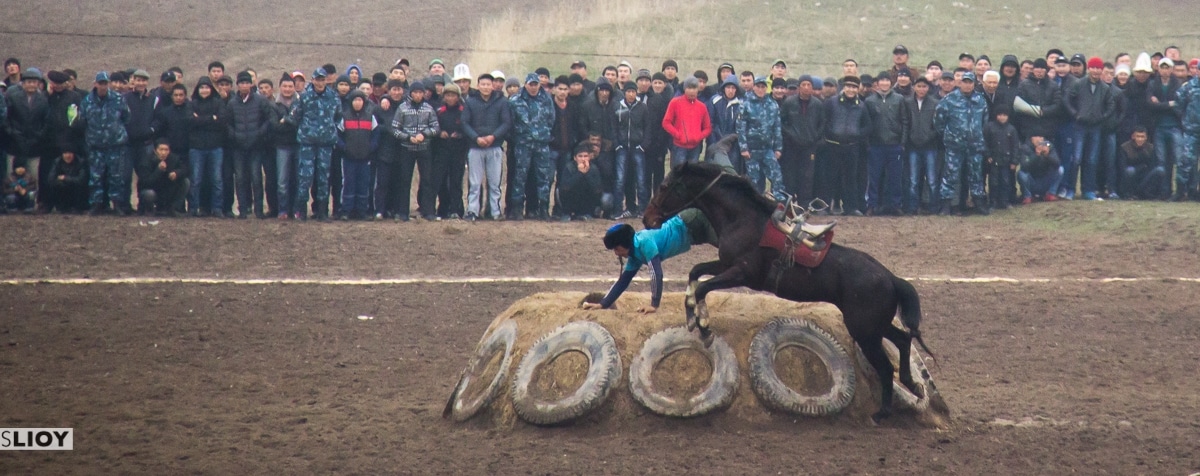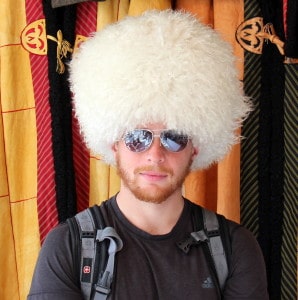Buzkashi and Kokpar – A Traditional Central Asian Horse Game
“Central Asian Dead Goat Polo”
For many foreigners I think the game of Buzkashi is THE stereotypical ‘Central Asia’ image.
As far back as Rambo III’s premiere in 1988, where Sly Stallone joins in a game of Buzkashi deep in the heart of Afghanistan, this crazy horseback battle over a decapitated goat carcass has somehow stuck in the public imagination.
While the Rambo portrayal may be a *bit* over the top (very rarely, for example, have I seen one rider deliberately elbow another in the face or gunships bear down on the field mid-match) it does capture the motion and excitement of watching a game.
The name ‘Buzkashi’ is actually from Afghanistan, though I’ve found it to be recognized in other countries as well. In Uzbekistan the same game is generally called ‘kok boru’ and in Kazakhstan ‘kokpar’ while in Kyrgyzstan one would more properly refer to it as ‘Ulak Tyrtysh’ instead.
Indeed, most of my experience is with ‘Ulak Tyrtysh’ in Bishkek. For most major holidays on the Kyrgyz calendar, one can reliably expect to find a game or two going on out at the city’s Ak-Kula Hippodrome stadium.
The strategy of the game itself is fairly simple: pick up a heavy goat carcass (the head and sometimes legs are generally removed), carry it down a field abour 200m long, and throw it into a big round basin that serves as your team’s goal. Sounds simple, right?
The difficulty of course comes in the form of a full team of horsemen trying to stop you and grab the goat for themselves, to race back down to the far end of the field.
This back and forth action can be really exciting or terribly slow, depending on which teams are playing. Many of the games I’ve seen in Bishkek have been relatively controlled affairs, with only a couple of charges into the crowd. The weekend of play I saw in Uzbekistan a few years ago, though, it seemed like every 30 or 40 seconds the beleaguered referee was madly blowing his whistle to try to prevent a stampede.
For the best players, this can be serious business. Prizes for the top matches range from wads of cash to brand new cars. Reportedly even the goat itself is worth quite a bit, and will often be auctioned off after the game to be eaten as especially-tender shashlik.
According to my friend Ainura’s mom in Bishkek, the history of the sport goes back to old nomadic traditions:
This game is rooted in hunting for a wolf from horseback. Several men on horses were trying to overtake and kill a wolf, and in the end they killed and played with dead wolf’s body by trying to take it from each other. Later men started to play with a dead sheep’s body and it became a ‘national game’. So this game’s real name -Kok Boru this is what Kyrgyz people always called. Later men started to play with goat’s dead body, but it was heavy so they switched to a lamb’s body as it was not as heavy. That’s why the game started to have another name like ” Ulak Tartysh”- in Kyrgyz ‘Ulak’ means a lamb, ‘Tartysh’ means pulling. Kokpar- Kok Boru the same as you know Kazakh and Kyrgyz languages almost the same as parts of the Turkish language family.
In the old time when Kyrgyz people lived in boz-uy [yurts – a type of semi-permanent tent popular in Central Asia and Mongolia] the goal of the game Kok Boru was to keep a goat/ lamb to each player’s own boz uy. And at that time it was not a group/team game: each person played for himself. Some strong man could throw a lamb’s body into a boz uy and the host of the boz uy would have a right to keep the body. However, if a game was just beginning players wanted to play further and they asked the host to give them back the goat/lamb. In this case players gave blesses/ wishes in Kyrgyz – Bata. After that a host could give the body back to players to keep playing. At the end of the day again a lamb/ goat can be kept in the last boz uy where was thrown and that boz uy host could eat the goat’s/lamb’s body and invite the neighbors. That was the end of the game. A host who kept a goat/lamb should give one later to future players when they play Kok Boru again. Finally, even if a goat/ lamb was thrown near to a boz uy but not inside the host could keep a goat/lamb by grabbing it and saying that it belongs to him.
Of course, with these rewards comes a certain element of risk too. I don’t recall having seen any grave injuries, but it isn’t exactly an uncommon event for a horse to slip and a rider to fall. In the middle of a pack of 8 or 10 horses, that poses a fairly serious danger of being trampled. Even as a spectator, this is a ‘get the blood pumping’ sort of sport. After a day of cheering and standing and watching in the blazing sun I often feel in need of a rest. I can’t even imagine the physical toll it must take on the riders and the horses!
There are several other popular horseback games in the region: Kyz Kuumai “bride chase” and Tyiyn Emmei “penny picker-upper” and Chaybash racing and sometimes horseback archery too.
None of these get nearly the reaction, however, as a good old game of Buzkashi.
Want a better idea of what Ulak Tartysh is like? Check out this video I put together of some of the highlights of three different matches (in Kyrgyzstan and Uzbekistan).
——–
If you’re trying to catch a game of Ulak-Tyrtysh at the Ak-Kula Hippodrome in Bishkek’s Pishpek neighborhood: minibusses 134, 136, 139 should all run out there from the Philharmonia stop. Alternatively, any marshrutka from the city center that runs west along Tolstoy should be able to drop you at the corner of ‘Temerchikova Sharshena’ street (opposite the small Pishpek Bazaar), from which the Hippodrome is a short walk south. If you’ve made it on the right day, you should be able to follow the crowds or the sounds of cheering.
None of the hostels I know of in Bishkek are particularly convenient to the Hippodome. However, the Tunduk Hostel comes with recommendations, the Kyrgyz Host hostel is one of the cheapest in town, and the Hostel Inn is extremely centrally located. Also, if you find yourself in town on days when they aren’t playing Ulak-Tyrtysh, be sure to check out my Bishkek Travel Guide for thoughts on other things to do in town.














